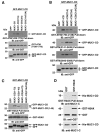MUC1-C Oncoprotein Interacts Directly with ATM and Promotes the DNA Damage Response to Ionizing Radiation
- PMID: 20865059
- PMCID: PMC2943399
- DOI: 10.1177/1947601910368059
MUC1-C Oncoprotein Interacts Directly with ATM and Promotes the DNA Damage Response to Ionizing Radiation
Abstract
The ataxia-telangiectasia mutated (ATM) kinase is activated in the cellular response to ionizing radiation (IR) and is of importance to the repair of DNA double strand breaks (DSBs). The MUC1 oncoprotein is aberrantly overexpressed in human breast carcinomas. The present work demonstrates that the MUC1 C-terminal subunit (MUC1-C) constitutively interacts with ATM in human breast cancer cells. We show that the MUC1-C cytoplasmic domain binds directly to ATM HEAT repeats. Our results also demonstrate that the MUC1-C cytoplasmic domain binds to the ATM substrate H2AX. The functional significance of these interactions is supported by the finding that MUC1-C promotes removal of IR-induced nuclear γH2AX foci. MUC1-C also protects against IR-induced chromosomal aberrations. In concert with these results, MUC1-C blocks IR-induced death by promoting repair of potentially lethal DNA damage. These findings indicate that the overexpression of MUC1 can protect against IR-induced DNA DSBs and may represent a physiologic response that has been exploited by malignant cells.
Conflict of interest statement
Dr. Kharbanda is an employee of Genus Oncology. Dr. Kufe is a founder of Genus Oncology and a consultant to the company. The other authors declare no potential conflicts of interest.
Figures






Similar articles
-
Activation of ataxia telangiectasia mutated by DNA strand break-inducing agents correlates closely with the number of DNA double strand breaks.J Biol Chem. 2005 Feb 11;280(6):4649-55. doi: 10.1074/jbc.M411588200. Epub 2004 Nov 15. J Biol Chem. 2005. PMID: 15546858
-
Depletion of ATR selectively sensitizes ATM-deficient human mammary epithelial cells to ionizing radiation and DNA-damaging agents.Cell Cycle. 2014;13(22):3541-50. doi: 10.4161/15384101.2014.960729. Cell Cycle. 2014. PMID: 25483091 Free PMC article.
-
Hyperthermia activates a subset of ataxia-telangiectasia mutated effectors independent of DNA strand breaks and heat shock protein 70 status.Cancer Res. 2007 Apr 1;67(7):3010-7. doi: 10.1158/0008-5472.CAN-06-4328. Cancer Res. 2007. PMID: 17409407
-
Involvement of DNA-PK and ATM in radiation- and heat-induced DNA damage recognition and apoptotic cell death.J Radiat Res. 2010;51(5):493-501. doi: 10.1269/jrr.10039. Epub 2010 Aug 28. J Radiat Res. 2010. PMID: 20814172 Review.
-
Roles for the DNA-PK complex and 53BP1 in protecting ends from resection during DNA double-strand break repair.J Radiat Res. 2020 Sep 8;61(5):718-726. doi: 10.1093/jrr/rraa053. J Radiat Res. 2020. PMID: 32779701 Free PMC article. Review.
Cited by
-
Impact of MUC1 mucin downregulation in the phenotypic characteristics of MKN45 gastric carcinoma cell line.PLoS One. 2011;6(11):e26970. doi: 10.1371/journal.pone.0026970. Epub 2011 Nov 2. PLoS One. 2011. PMID: 22073229 Free PMC article.
-
Addiction of Merkel cell carcinoma to MUC1-C identifies a potential new target for treatment.Oncogene. 2022 Jul;41(27):3511-3523. doi: 10.1038/s41388-022-02361-3. Epub 2022 Jun 10. Oncogene. 2022. PMID: 35688945 Free PMC article.
-
MUC1 and MUC4: switching the emphasis from large to small.Cancer Biother Radiopharm. 2011 Jun;26(3):261-71. doi: 10.1089/cbr.2011.1017. Cancer Biother Radiopharm. 2011. PMID: 21728842 Free PMC article. Review.
-
Mathematical modelling of phenotypic plasticity and conversion to a stem-cell state under hypoxia.Sci Rep. 2016 Feb 3;6:18074. doi: 10.1038/srep18074. Sci Rep. 2016. PMID: 26838463 Free PMC article.
-
MUC1-C oncoprotein suppresses reactive oxygen species-induced terminal differentiation of acute myelogenous leukemia cells.Blood. 2011 May 5;117(18):4863-70. doi: 10.1182/blood-2010-10-296632. Epub 2011 Mar 21. Blood. 2011. PMID: 21422470 Free PMC article.
References
-
- Lavin M, Kozlov S. ATM activation and DNA damage response. Cell Cycle 2007;6:931-42 - PubMed
-
- Abraham RT. Cell cycle checkpoint signaling through the ATM and ATR kinases. Genes Dev 2001;15:2177-96 - PubMed
-
- Burma S, Chen B, Murphy M, Kurimasa A, Chen D. ATM phosphorylates histone H2AX in response to DNA double-strand breaks. J Biol Chem 2001;276:42462-7 - PubMed
-
- Rogakou EP, Pilch DR, Orr AH, Ivanova VS, Bonner WM. DNA double-stranded breaks induce histone H2AX phosphorylation on serine 139. J Biol Chem 1998;273:5858-68 - PubMed
Grants and funding
LinkOut - more resources
Full Text Sources
Other Literature Sources
Research Materials
Miscellaneous
